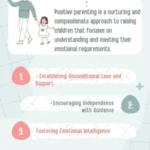Positive parenting is a transforming strategy that focuses on nurturing children in a manner that encourages their emotional and psychological growth while preserving a strong and loving parent-child relationship. We are devoted to giving you with helpful insights on positive parenting strategies that may enable you to raise well-adjusted and emotionally healthy children.
The Core of Positive Parenting: The 4 C’s
Positive parenting may be condensed into four key ideas, sometimes referred to as the 4 C’s. These principles act as a compass for parents, leading them towards building a good and loving environment for their children. Let’s look into each of these crucial components:

1. Communication
Effective communication is the cornerstone of effective parenting. It entails attentive listening, empathy, and open interaction between parents and children. When parents actively interact with their children, they create an atmosphere where the child’s ideas, emotions, and views are accepted and treasured. Effective communication is the linchpin of positive parenting, serving as the conduit for understanding, empathy, and connection between parents and children. It transcends mere verbal exchange, delving into the realm of active listening and creating a space where a child’s thoughts, emotions, and perspectives are not just heard but valued. In practicing positive communication, parents become attuned to their children’s needs, fostering an environment of trust and open dialogue.
Encouraging active listening entails dedicating uninterrupted time to comprehend a child’s ideas and feelings. By doing so, parents signal that their child’s thoughts are not only significant but also worthy of undivided attention. Empathy further enriches communication by acknowledging and responding to a child’s emotions with sensitivity. When a child feels seen and heard, a foundation of trust is laid, allowing for deeper connections to flourish.
Open dialogue, the third pillar of effective communication, entails creating a secure space where children feel comfortable expressing themselves. This involves fostering an environment free from judgment, where children can openly share their thoughts, fears, and dreams. By instilling a culture of communication that values the child’s perspective, positive parenting strengthens the parent-child bond, facilitating emotional growth and mutual understanding.
2. Connection
Building a deep emotional connection between parents and children is vital. Positive parenting stresses the value of developing a solid relationship with your kid. When children feel linked to their parents, they are more inclined to trust and seek direction from them.
Building a profound emotional connection between parents and children stands as a cornerstone in positive parenting. This connection goes beyond the roles of caregiver and child; it signifies a bond steeped in trust, understanding, and unwavering support. Positive parenting places a premium on cultivating this connection, recognizing its pivotal role in shaping a child’s sense of security and self-worth.
Quality time, the first facet of fostering connection, involves intentional and meaningful engagement with a child’s interests and activities. By actively participating in a child’s world, parents not only create lasting memories but also convey a powerful message of commitment and prioritization. Physical love, the second element, underscores the importance of affectionate gestures such as hugs and embraces. These acts of physical warmth contribute to a child’s emotional well-being, reinforcing the idea that love is not just spoken but also felt.
Positive reinforcement, the third component, serves as a catalyst for strengthening the parent-child connection. This involves acknowledging and praising positive behavior, fostering a cycle of encouragement and motivation. By actively recognizing a child’s achievements and efforts, parents contribute to a positive emotional climate, deepening the emotional connection between parent and child.
3. Consistency
Consistency in parenting is crucial for a child’s growth. Positive parenting promotes parents to create clear and consistent limits and guidelines. When parents establish a consistent environment, children feel safe and are more likely to comprehend expectations and consequences.
Consistency forms the bedrock of positive parenting, providing a stable and predictable environment that is essential for a child’s development. This principle manifests in three interconnected aspects: establishing rules, enforcing sanctions, and maintaining a predictable routine.
Establishing clear and age-appropriate rules is the initial step in promoting consistency. These rules serve as guidelines that delineate acceptable behavior and set expectations. By communicating expectations clearly, parents provide children with a framework for understanding boundaries and navigating their world.
Consistent enforcement of sanctions is the second facet of this principle. When rules are not followed, parents must apply consequences consistently and equitably. This approach instills a sense of fairness and accountability, reinforcing the understanding that actions have consequences. By adhering to a consistent disciplinary approach, parents contribute to an environment where children feel secure and understand the parameters of acceptable behavior.
A predictable routine forms the third dimension of consistency. Creating a daily schedule that offers structure and predictability is vital for a child’s sense of security. Routines provide a framework for daily activities, reducing anxiety and promoting a sense of order. Whether it involves mealtimes, bedtime rituals, or playtime, a consistent routine contributes to a harmonious and well-balanced family life.
4. Consequences
Positive parenting doesn’t imply avoiding penalties for misbehaving. Instead, it focuses on employing consequences that are fair, age-appropriate, and targeted at educating rather than punishing. Consequences are supposed to help youngsters realize the consequences of their actions and learn from their errors.
Positive parenting redefines the concept of consequences, emphasizing their role as instructive tools rather than punitive measures. The approach revolves around employing consequences that are fair, age-appropriate, and geared towards educating rather than punishing.
Natural consequences, the first dimension, allow children to experience the inherent outcomes of their behavior when it’s safe to do so. This hands-on learning approach enables children to connect their actions with results, fostering responsibility and critical thinking. Natural consequences provide valuable life lessons in a controlled environment, allowing children to comprehend the impact of their choices.
Logical consequences, the second facet, are consequences that are directly related to the transgression and offer a meaningful lesson. Rather than punitive measures, logical consequences aim to guide children toward better decision-making. By linking the consequence to the misbehavior, parents provide a context for understanding and encourage a sense of accountability.
Positive reinforcement, the third component, complements consequences by emphasizing and rewarding positive behavior. This approach involves acknowledging and praising desirable actions, creating an environment where children feel motivated to make positive choices. By actively reinforcing positive behavior, parents contribute to a constructive and supportive atmosphere that encourages continual growth and learning.
Putting the 4 C’s into Practice
Effective Communication
- Active Listening: Take the time to listen intently to your child’s ideas and emotions without interruption.
- Empathetic Responses: Show empathy by noticing your child’s feelings and offering comfort when required.
- Open Dialogue: Encourage open and honest conversation by establishing a secure environment for your kid to express themselves.
Building Connection
- Quality Time: Spend quality time with your kid, participating in things that they like.
- Physical love: Offer hugs, embraces, and physical love to enhance your emotional connection.
- Positive Reinforcement: Use praise and positive reinforcement to enhance your relationship.
Maintaining Consistency
- Establishing Rules: Clearly outline rules and expectations that are age-appropriate for your kid.
- Consistent Enforcement: Enforce sanctions consistently and equitably when rules are not followed.
- Predictable Routine: Create a daily routine that gives structure and predictability for your youngster.
Applying Consequences
- Natural Consequences: Allow youngsters to experience the natural consequences of their behavior when it’s safe to do so.
- Logical Consequences: Implement logical consequences that are relevant to the transgression and deliver a meaningful lesson.
- Positive Reinforcement: Reward positive conduct with praise and prizes to promote its continuance.
The Impact of Positive Parenting
Research regularly reveals that good parenting approaches have a dramatic influence on a child’s development. Children reared in a happy parental setting tend to display better conduct, emotional control, and general well-being. They are more likely to have stronger self-esteem and create healthier relationships in the future.
FAQs on Positive Parenting and the 4 C’s:
1. What is the essence of positive parenting, and how does it differ from traditional parenting?
Positive parenting is a transformative strategy that prioritizes the emotional and psychological growth of children while maintaining a strong parent-child relationship. Unlike traditional parenting, it focuses on fostering understanding, empathy, and open communication, steering away from punitive measures towards fair consequences that educate children about the outcomes of their actions.
2. How can effective communication be achieved in positive parenting, and why is it crucial?
Effective communication in positive parenting involves active listening, empathy, and open dialogue, creating an atmosphere where a child’s thoughts and emotions are valued. It is crucial because it serves as a linchpin for understanding, empathy, and connection between parents and children, fostering an environment of trust and mutual understanding.
3. What role does building a deep emotional connection play in positive parenting?
Building a profound emotional connection is vital in positive parenting, going beyond caregiver roles to signify a bond steeped in trust, understanding, and unwavering support. This connection encourages trust and prompts children to seek guidance and support from their parents.
4. Why is consistency emphasized in positive parenting, and how does it contribute to a child’s growth?
Consistency is crucial in positive parenting as it provides a stable and predictable environment necessary for a child’s development. It involves establishing clear rules, consistent enforcement of sanctions, and maintaining a predictable routine, helping children feel safe and comprehend expectations and consequences.
5. How does positive parenting redefine the concept of consequences, and what impact does it have on a child’s learning and development?
Positive parenting redefines consequences as instructive tools rather than punitive measures, focusing on fair, age-appropriate consequences that educate children. Natural consequences allow hands-on learning, fostering responsibility, while logical consequences guide children toward better decision-making. This approach, complemented by positive reinforcement, creates an environment promoting continual growth and learning.
In Conclusion
The Core of Positive Parenting, encapsulated in the 4 C’s—Communication, Connection, Consistency, and Consequences—serves as a compass for parents, guiding them towards creating a nurturing environment for their children. Implementing the 4 C’s in daily practice enhances the parent-child relationship, promotes emotional growth, and contributes to well-adjusted, resilient children. Extensive research consistently highlights the positive impact of good parenting approaches, underscoring the importance of fostering a happy parental setting for overall child development.





